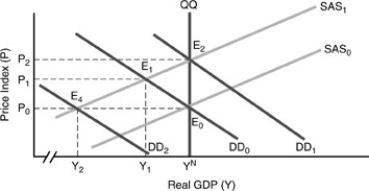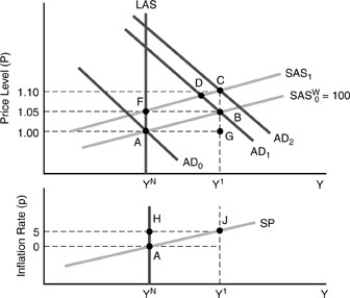A) A.
B) C.
C) D.
D) E.
Correct Answer

verified
Correct Answer
verified
Multiple Choice
A positive relationship between inflation and unemployment emerged in
A) 1963-70.
B) 1974-75.
C) 1986-90.
D) All of the above
Correct Answer

verified
Correct Answer
verified
Multiple Choice
Assume adaptive expectations.Compared to a simple one-period lag,if the last five periods' inflation rates are averaged to arrive at currently expected inflation,we have ________ disinflationary loops and ________ recessions accompanying disinflationary policy
A) skinnier,milder
B) skinnier,deeper
C) fatter,milder
D) fatter,deeper
Correct Answer

verified
Correct Answer
verified
Multiple Choice
The European Monetary System
A) broke down in 1990 and resulted in a resurgence of inflation in many European countries.
B) was still in place in 1996 but was permitting frequent exchange rate adjustments.
C) came to an end in 1992 and was followed by devaluations in Italy,the U.K.and several other countries.
D) has been a successful experiment in fixed exchange rates and was still in place as of 1996.
Correct Answer

verified
Correct Answer
verified
Multiple Choice
From a long-run equilibrium with p = pe = 0,suppose x rises to 6.If initially pe remains at zero and p rises to 4,Y becomes
A) 110.
B) 102.
C) 98.
D) 96.
Correct Answer

verified
Correct Answer
verified
Multiple Choice
Government price controls act as ________ supply shock,shifting SP ________.
A) an adverse,downward
B) an adverse,upward
C) a beneficial,downward
D) a beneficial,upward
Correct Answer

verified
Correct Answer
verified
Multiple Choice
Inflation is a ________ increase in the price level and it can be produced if the AD curve shifts up ________.
A) continuous,continuously
B) continuous,either once or continuously
C) one-shot,once but only once
D) one-shot,either once or continuously
Correct Answer

verified
Correct Answer
verified
Multiple Choice
The rate of inflation will be permanently reduced provided
A) the rate of monetary growth is permanently reduced.
B) the government balances the budget.
C) people behave rationally.
D) there is a Pigou effect.
Correct Answer

verified
Correct Answer
verified
Multiple Choice
Given an adverse supply shock,a "neutral policy" will
A) maintain the inflation rate and the output ratio.
B) lower the inflation rate and the output ratio.
C) raise the inflation rate and the output ratio.
D) maintain the inflation rate but lower the output ratio.
Correct Answer

verified
Correct Answer
verified
Multiple Choice
From an initial AD/SAS/LAS equilibrium with price and wage index numbers of 1.00 and an output index number of 100,suppose a new SAS curve must be drawn for a wage level of 1.03.Applying a general rule for drawing SAS curves,it goes through the
A) current AD curve at Y = 103.
B) current AD curve at P = 1.03.
C) LAS curve at Y = 103.
D) LAS curve at P = 1.03.
Correct Answer

verified
Correct Answer
verified
Multiple Choice
If the average unemployment rate = 6.0,Y = 5200,and YN = 5030,Okun's law,using the textbook's value for "h," predicts that the unemployment rate is approximately ________ percent.
A) 7.4
B) 6.4
C) 4.3
D) 5.6
E) 5.0
Correct Answer

verified
Correct Answer
verified
Multiple Choice
Lucas's idea of information barriers as applied to the formation of inflation expectations is an example of
A) forward-looking expectations.
B) backward-looking expectations.
C) adaptive expectations.
D) irrational expectations.
Correct Answer

verified
Correct Answer
verified
Multiple Choice
Figure 8-3
 -Employing Figure 8-3 above and assuming the nominal money supply is not altered,a permanent adverse supply side shock puts ________ pressure on nominal wages during renegotiation provided ________.
-Employing Figure 8-3 above and assuming the nominal money supply is not altered,a permanent adverse supply side shock puts ________ pressure on nominal wages during renegotiation provided ________.
A) no;the reduction in the natural real GDP YN to Y₁ is exactly offset by the fall in goods demanded due to the rise in the price level
B) downward;the reduction in the real GDP YN to Y₂ is exactly offset by the fall in goods demanded due to the rise in the price level
C) upward;the reduction in the natural real GDP is exactly offset by the fall in goods demanded due to the rise in the price level
D) no;since the natural real GDP does not change
Correct Answer

verified
Correct Answer
verified
Multiple Choice
Figure 8-5
 -In Figure 8-5 above,from initial point A in the top diagram AD₀ shifts to AD�₁,while the nominal wage remains constant.Short-run equilibrium occurs at point
-In Figure 8-5 above,from initial point A in the top diagram AD₀ shifts to AD�₁,while the nominal wage remains constant.Short-run equilibrium occurs at point
A) G.
B) B.
C) C.
D) D.
E) F.
Correct Answer

verified
Correct Answer
verified
Multiple Choice
If nominal GDP growth has accelerated permanently (assuming Y(N) ,is constant) ,
A) real GDP must keep growing until the growth rate of nominal GDP equals the inflation rate.
B) real GDP will increase by the same percentage that nominal GDP increased.
C) real GDP must keep growing until the rate of growth of real GDP equals the inflation rate.
D) the level of real GDP will be permanently increased.
Correct Answer

verified
Correct Answer
verified
Multiple Choice
Can monetary policy maintain a constant price level when confronted with the effects of an adverse supply shock?
A) Yes,if the economy is characterized by real and/or nominal wage rigidity.
B) No,if the economy is characterized by real and/or nominal wage rigidity.
C) Yes,if the economy is characterized by continuous renegotiation.
D) No,if the economy is characterized by overlapping contracts.
Correct Answer

verified
Correct Answer
verified
Multiple Choice
A rise in expected inflation causes
A) the SP curve to shift upward.
B) the SP curve to shift downward.
C) a movement upward along the SP curve.
D) a movement downward along the SP curve.
Correct Answer

verified
Correct Answer
verified
Multiple Choice
COLAs ________ the probability that a permanent adverse supply shock will permanently increase an economy's ________.
A) increase,inflation rate
B) increase,price level
C) decrease,inflation rate
D) decrease,price level
Correct Answer

verified
Correct Answer
verified
Multiple Choice
Beneficial supply shocks ________ the rate of inflation and ________ the natural rate of unemployment.
A) reduce,reduce
B) reduce,increase
C) increase,reduce
D) increase,increase
Correct Answer

verified
Correct Answer
verified
Multiple Choice
An acceleration of nominal GDP growth from,say 4% to 6% will
A) permanently raise the rate of inflation.
B) temporarily lower the rate of inflation.
C) leave real GDP unaffected in the long run.
D) Both A and C.
Correct Answer

verified
Correct Answer
verified
Showing 81 - 100 of 191
Related Exams